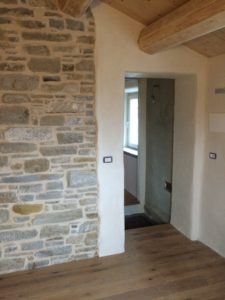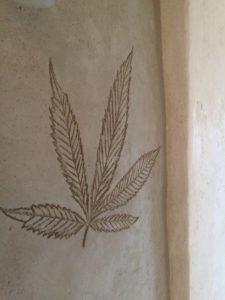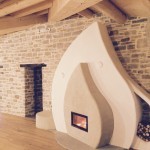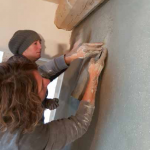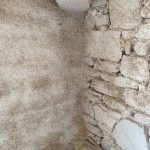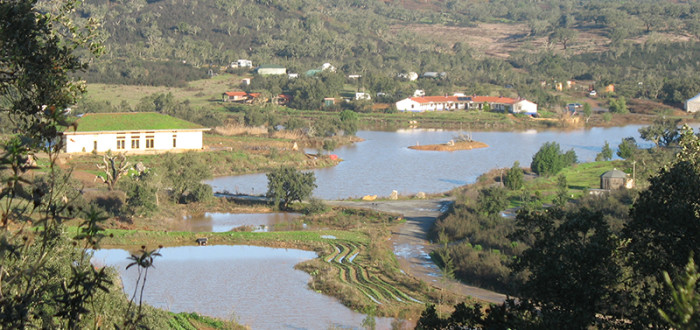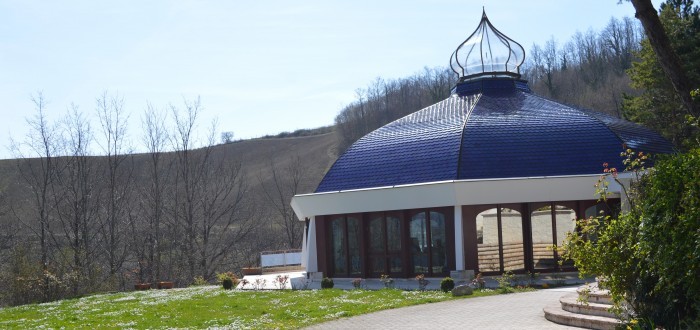EARTHSHIP: self-sufficient living at La Fattoria dell’Autosufficienza – Italy
Beside being the primary element for farming activities, synergistic vegetable gardens, animals and the Farm’s life in general, the earth is also used as an element for constructing particular natural buildings and architectural structures.
Since the renovation of the old farmhouse by using local stones and clay, earth has been widely employed and modelled for plasters, lamps, decorations, as well as for the big stove made of fire clay at the centre of the building which will be used to heat the restaurant area.
What is the Earthship
Now that the Farm is heading toward a new and important development, earth will have an even more important role and greater implications. The new extension works that have just been approved by the municipality of Bagno di Romagna are originally inspired by a particular construction model: the Earthship. The Earthship has an ecological footprint and it exploits the earth and its natural thermal mass as determining factor for reducing consumption.
The Earthship is a prototype of radical sustainable building that was conceived in the 1970’s by Michael Raynholds, who stated: “…the Earthship is the epitome of sustainable design and construction. No part of sustainable living has been ignored in this ingenious building”.
The first projects have been realised in American desert areas and in recent years this technique has spread in Europe too. The buildings constructed following the Earthship method are to be considered passive natural buildings and their strong point is that they use the earth as main material, also thanks to their particular semi-underground conformation.
Even if they are underground structures, they are characterised by their greenhouse-like glass façade that allows to get direct energy from the sun, climate control and a living quality that is greatly appreciated and also allows to grow plants within the building. Both for constructing and maintaining the Earthship, the tendency is to prefer low-tech construction technologies, that is to say not using too advanced mechanic and electric systems that require a huge waste of energy and maintenance, hence reducing construction and conservation costs for all the life cycle of the building. These are the reasons why Earthship buildings have been achieving resounding success all over the world.
The new development of La Fattoria dell’Autosufficienza
The new extension of the Farm is inspired by this kind of construction, but it was further developed and re-elaborated in a more articulated project in order to better adapt to the place, climate conditions, function and construction restrictions of the area.
The “re-elaborated Earthship” designed for the Farm is the result of years of observations that took into account all the factors and activities that have been developing at La Fattoria dell’Autosufficienza, according to permaculture principles.
During the design phase the starting point was an integrated vision of permaculture and applied sustainable architecture which started at the Farm in 2010 and that have been developing ever since.
The whole project allowed the renovation and reconversion of the old crumbling buildings into a multi-functional recreational centre and agritourism that will host the main activities of La Fattoria dell’Autosufficienza.
Starting from the particular orographic conformation of the site, the new project exploits the most the difference of ground levels which are appropriate for the Earthship construction.
The development of the project started from the existing structure of the old farmhouse around which the Earthship will rise with its particular shape that on paper resembles a “crescent moon”. This shape allows to reduce the volume and the visive impact on the slope (and this is a fundamental requirement for an extension of this size in an area subjected to construction restrictions), and it also responds well to hydrogeological issues.
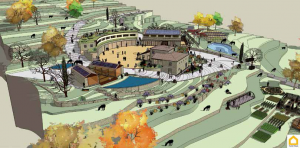
A crescent-moon-shaped building and a sun-shaped square.
The crescent-moon-shaped building will host all the new activities of the Farm: from multipurpose meeting rooms, to laboratories for vegetal production; from convivial spaces and the organic and vegan shop, to particular rooms for the agritourism’s guests. The whole building will be connected to the overlooking sun-shaped square: “La piazza dell’Autosufficienza” (the Self-sufficiency Square).
The square, that have a beautiful viewpoint, will be the ideal place for events, markets, and shows inspired by this vision of conscious living which takes distance from conventional consumer processes.
Overall the project has been conceived as a kaleidoscope of the most recent and advanced construction techniques of green building that have a common thread: the earth. There will be straw bale buildings, green roofs and walls made of cob (clay, straw, sand and water), all natural materials made of earth or created from it. The buildings will be natural, with soft shapes and no sharp corners.
Even the symbolic aspect is very important: the sun-shaped square and the crescent-moon-shaped Earthship represent the incessant day/night cycle, the essence of the biological and human self-sufficiency.
The earth, mother of everything and construction material of the buildings, becomes a fundamental constructive element at the Farm. Together with water (present in abundance), air, sun and fire (available thanks to the great amount of firewood), we complete the cycle of the cosmos’ fundamental elements. From these primary elements La Fattoria dell’Autosufficienza wants to restart in a simple way but with a modern take.
The new project has the aim to experiment, propose, teach and demonstrate how it is possible to build human settlements that are sustainable in the long term. It will become a food and energy production model of noteworthy relevance at national and international level and definitely a unique and innovative experience among Italian sustainable activities.

Main features of an Earthship building
1) Thermal/solar heating and cooling.
Earthship buildings keep comfortable temperatures regardless of the climate. Our planet is a huge thermic mass that guarantees a comfortable temperature with no need for wires or pipes. The sun is a nuclear power plant that provides energy without wires or connections.
2) Wind and solar electricity.
Earthship buildings produce their own electric energy thanks to a solar and a wind power plant. This energy is stored in batteries and provides electricity to the whole electric system. Earthship buildings can have different integrated energy production systems.
3) Treatment of waste water.
Earthship buildings reuse all household effluents thanks to internal and external treatment systems. The resulting water can be used for food production or irrigation systems, while greywater from toilets goes through a particular treatment without generating bad smells.
4) Use of natural and recycled materials.
The house should be an assembly work of by-products. A sustainable house must employ local materials that can be naturally found within the local territory.
5) Water storage.
Earthship buildings take water from the sky (rain and melted snow) and then use it four times. Water is heated by the sun. Earthship buildings can be connected to the water supply network, but they don’t pollute aquifers.
6) Self-sufficient food production.
Earthship buildings have simplified systems of water storage that, together with the greenhouse, allows the cultivation of vegetables within the building in order to have fresh self-produced products.
Filo di Paglia – Natural Architecture
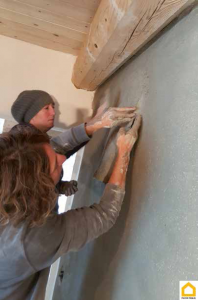 The project of the Multi-functional Centre of La Fattoria dell’autosufficienza has been designed by the Architectural firm “Filo di Paglia”. The architect Andrea Gilardi and Francesca Romaniello, founders of the famous firm specialised in straw bale constructions, have gained 20 years of experience in green building and developing projects of activities in transition that aim for food and energy self-sufficiency.
The project of the Multi-functional Centre of La Fattoria dell’autosufficienza has been designed by the Architectural firm “Filo di Paglia”. The architect Andrea Gilardi and Francesca Romaniello, founders of the famous firm specialised in straw bale constructions, have gained 20 years of experience in green building and developing projects of activities in transition that aim for food and energy self-sufficiency.
Beside designing and planning, Filo di Paglia also experiments innovative and natural techniques applied to constructions, as well as taking care of their practical realisation. The plasters and decorations of the Farm, made of cob, lime and hemp, were made by hand by Andrea and Francesca.
Andrea and Francesca are “natural builders”, that is to say they construct green buildings. In fact, they directly work on site together with construction enterprises or when directing educational building sites.
Info and contacts
Andrea Gilardi: andrea-gilardi@libero.it
Francesca Romaniello: fraromaniello@libero.it
www.filodipaglia.it
http://www.facebook.com/filo.dipaglia
Newsletter
ARGOMENTI
- Activities (8)
- Attività (10)
- Attrattive (16)
- Cosa fare (22)
- Farm products (4)
- Fattoria dell'autosufficienza (62)
- Fattoria dell'autosufficienza (40)
- Fauna (8)
- Flora (5)
- I nostri modelli (15)
- Istruzioni per viaggiare (2)
- News (63)
- News (97)
- Our models (14)
- Permacultura (30)
- Permaculture (23)
- Prodotti della fattoria (4)
- Senza categoria (2)
- Senza categoria (4)
- Things to do (22)
- Tourist attractions (15)


